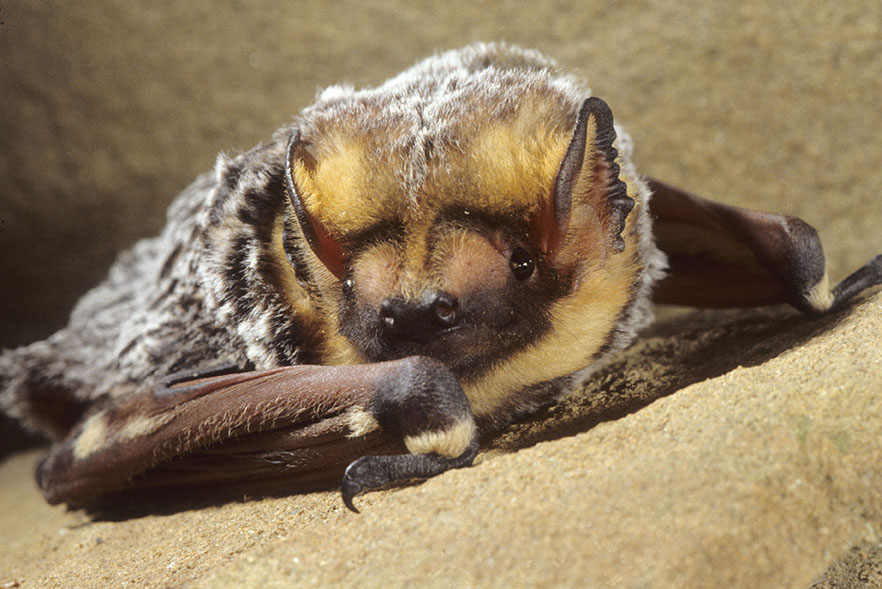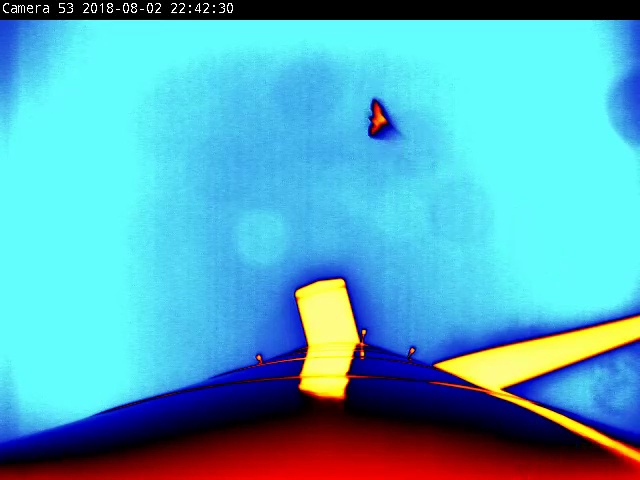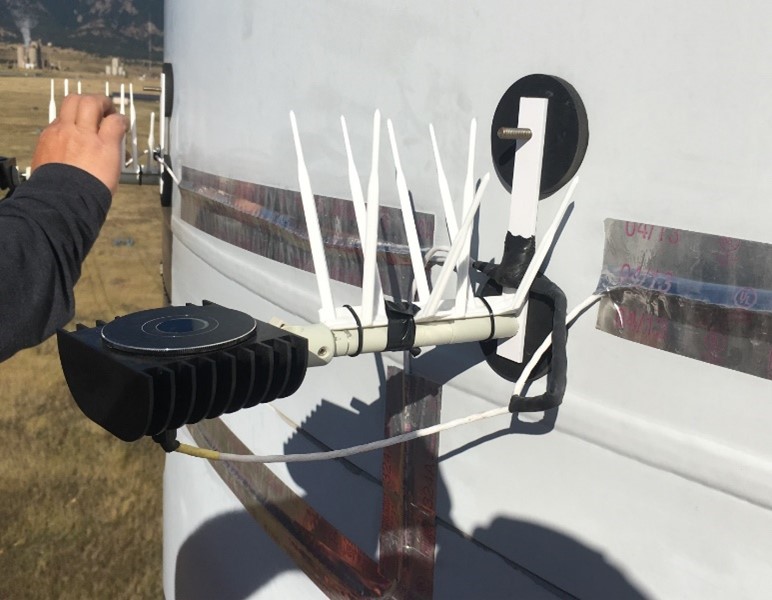Wind Turbines and Bats

Whether considering a site for wind energy development or operating an existing wind energy site, it is important to consider—and strive to minimize—impacts on species like this hoary bat pictured above. Photo from John McGregor, Kentucky Department of Fish & Wildlife Resources
Are Wind Turbines Dangerous to Bats?
As a source of affordable, homegrown power, wind energy offers many advantages. However, although wind energy sites rank lower than other energy generating facilities in terms of environmental impacts, wind turbines still pose a considerable risk to bats who occupy the same airspace. Some species of bats collide with wind turbine blades. These collisions occur most often during late summer and fall when bats are migrating and mating.
Research indicates that long-distance migratory species, like the hoary bat (pictured), eastern red bat, silver-haired bat, and Brazilian (or Mexican) free-tailed bat, are the most active, and therefore most at risk around wind turbines. Complicating matters, many bat species seem to be attracted to wind turbines.
This is why members of the wind energy industry, the U.S. Department of Energy’s Wind Energy Technologies Office (WETO) and its national labs, and other research institutions support work to better understand bat behavior and lower the risk for all wildlife, including birds, marine mammals, and bats.
How Do We Protect Bats From Wind Turbines?
Fortunately, wind energy site developers and operators have several strategies to understand and reduce wind energy’s impact on bats. These strategies (explained further in the sections below) include:
- Screening a potential wind energy site for bat activity.
- Monitoring bat mortality at operating wind energy sites.
- Curtailing wind turbine operation (by slowing, stopping, or changing the direction of blade rotation) at times when bats are likely to be present.
- Discouraging bats from approaching wind turbines with deterrent technologies.
Guidelines and environmental regulations for land-based, offshore, and distributed wind energy projects also help minimize impacts on bats. For example, the U.S. Fish and Wildlife Service Wind Turbine Guidelines Advisory Committee offers Land-Based Wind Energy Guidelines.
Researchers develop ways to monitor and mitigate the impact of wind energy development on bats. These efforts are sponsored by WETO, national labs (see the Tethys database of wind energy and bats publications), and other institutions and collaborations in the industry (like the Bats and Wind Energy Cooperative, an alliance of experts from government agencies, private industry, academic institutions).
Let’s take a closer look at each of these strategies and where they fit into the wind energy site development, construction, operation, and decommissioning process.
Screening Potential Wind Energy Sites for Bat Activity
As is the case with birds, the best way to keep bats safe from wind turbines is to avoid building turbines in areas with high bat activity. Therefore, when selecting a wind energy site, developers should screen for bat activity during the preconstruction phase—before construction begins. This will help determine the potential impact a wind energy facility will have on local bats.
Screening a potential wind energy site for bat activity involves conducting acoustic monitoring studies to identify species and activity patterns associated with seasonal, weather, and habitat conditions. It is also important to identify any environmental characteristics that may attract bats, including:
- Trees, caves, and similar spaces to roost and raise young
- Migration paths and stopover sites
- Winter hibernation sites like caves, mines, and rock crevices.
Monitoring Bat Activity at Potential Sites
Prior to the installation of wind turbines, regulators and developers can use different tools and tactics to monitor bat activity at potential wind energy sites to evaluate risk and determine if the site is appropriate or requires mitigation strategies.
Acoustic Monitoring at Potential Sites
Bats emit high-frequency sounds and listen for the echoes that bounce off the objects around them. This adaptation, which is called echolocation, helps bats navigate their surroundings and hunt for food in the dark.
Acoustic monitoring technology uses special microphones to record bats’ echolocation calls before construction, providing data that can help developers identify which bat species are active in an area. Microphones can be positioned on the ground, but it is useful to mount the microphones higher up—on a meteorological tower, for example—to capture bat activity at the height where a wind turbine’s blades will operate. The Bat Acoustic Monitoring Portal is a useful tool for archiving and visualizing bat acoustic data throughout the year.
Radar Monitoring at Potential Sites
In the ocean, floating buoys can employ radar equipment to monitor the behavior and abundance of flying animals, like bats. This would address the challenge of evaluating animal activity at offshore sites that may be in consideration for offshore wind energy development.
Tag and Transmitter Monitoring at Potential Sites
As with golden eagles, using radio-frequency tags and transmitters can help researchers learn more about bat behavior, flight patterns, and favored areas or habitats, which can help guide wind energy developers toward sites with less activity and simplify environmental permitting processes.
Monitoring Bat Mortality at Operating Wind Energy Sites
Once a wind farm is operational, operators can use several monitoring approaches to assess the wind farm’s impact on bats and to help develop strategies to minimize bats’ interactions with turbines. These include mortality monitoring, acoustic monitoring, and thermal imaging.
Mortality Monitoring at Operating Sites
Mortality monitoring should be conducted within the first year or two of an operational wind energy site. This involves searching the ground under wind turbines for any bats that may have collided with a wind turbine. Surveys are often conducted by human searchers, but dogs have also been used. Mortality monitoring often occurs between spring and fall to account for the time bats are active.
Acoustic Monitoring at Operating Sites
Positioning acoustic microphones on the wind turbine nacelle (the cover that houses a turbine’s energy generating components), can provide real-time data on when bats are near the wind turbines and at risk. The data collected can help operators develop more precise impact minimization strategies, such as curtailment.
Thermal Imaging at Operating Sites
Thermal imaging cameras convert heat into visible images, allowing users to monitor bats when it is too dark for humans to see them well. These images help researchers understand why some bats species approach and spend time flying near wind turbines. Research, funded by WETO, to learn bats’ behavior near wind turbines may help improve existing impact minimization strategies or develop new approaches.

Strategies like acoustic monitoring, roost surveys, thermal imaging (like this one, showing a bat flying past a wind turbine tower), and wind turbine curtailment can help minimize a wind energy project's impact on bats. Photo from John Yarbrough, National Renewable Energy Laboratory
Complementary Tools
As bat monitoring tools, acoustic monitoring and thermal imaging complement each other in important ways. Although acoustic data can help identify the bat species at a given site, it can’t show how the bats are behaving. In addition, acoustic monitors have a short range in which they can detect bats.
Meanwhile, thermal cameras are unable to distinguish bat species, but they can show how bats behave at a potential wind site or around existing wind turbines. Thermal cameras also have a wide range of detection, meaning they can capture a lot of bird and bat activity within the rotor-swept area of a wind turbine.
For these reasons, in many cases, it is beneficial to use acoustic monitoring and thermal imaging in conjunction with each other, as well as with curtailment methods.
Curtailing Wind Turbines When Bats Are Present
When bats are present, or expected to be present, at a wind energy site, operators can curtail wind turbine operations, meaning they slow down or stop the rotation of a wind turbine’s blades. This allows bats to navigate around the turbine’s blades without risk of collision.
Wind farm operators often based their curtailment strategies on the time of year and wind speed. Years of data have shown that bats are most at risk near turbines during late summer and early fall when wind speeds are relatively low. For example, curtailing at night from mid-July to early October when wind speeds are below 5 meters per second has consistently proven to reduce bat collisions. However, curtailment can result in a loss of power generation and may not be an effective strategy for all wind energy sites or for all bat species.
To minimize energy loss while reducing collisions, many wind farm operators use smart curtailment. This approach incorporates additional data like temperature or real-time bat activity measured from acoustic microphones to determine whether a turbine should be curtailed. This helps operators avoid unnecessary curtailment while reducing the wind farm’s impact bats.

Studies explore if ultraviolet lights (like the one pictured) can help deter bats from wind turbines. Photo from Bethany Straw, U.S. Geological Survey
Discouraging Bats from Approaching Wind Turbines
At existing wind energy sites where bats are known to be active, operators can use deterrent technologies to discourage bats from approaching wind turbines.
In some cases, deterrents can help keep bats away from wind turbines, which allows wind farms to operate normally without having to curtail operations when bats are present. However, it is difficult to emit high-frequency sound far enough for bats to hear and be able to respond to quickly enough to avoid the spinning wind turbine blades. Acoustic deterrent devices, which can be installed on wind turbines, broadcast ultrasound, (i.e., sounds above human hearing) at the same frequency bats use for echolocation. This can interfere with bats’ ability to perceive echoes and therefore their ability to navigate and find food. As a result, the bats may decide to move to a different area. Read a short science summary about ultrasonic bat deterrents.
Other studies including national labs and federal agencies have explored whether dim, flickering ultraviolet light can deter bats from approaching wind turbines. Read a short science summary.
Researchers are working to explore new types of and to improve existing deterrent technologies to increase their effectiveness.